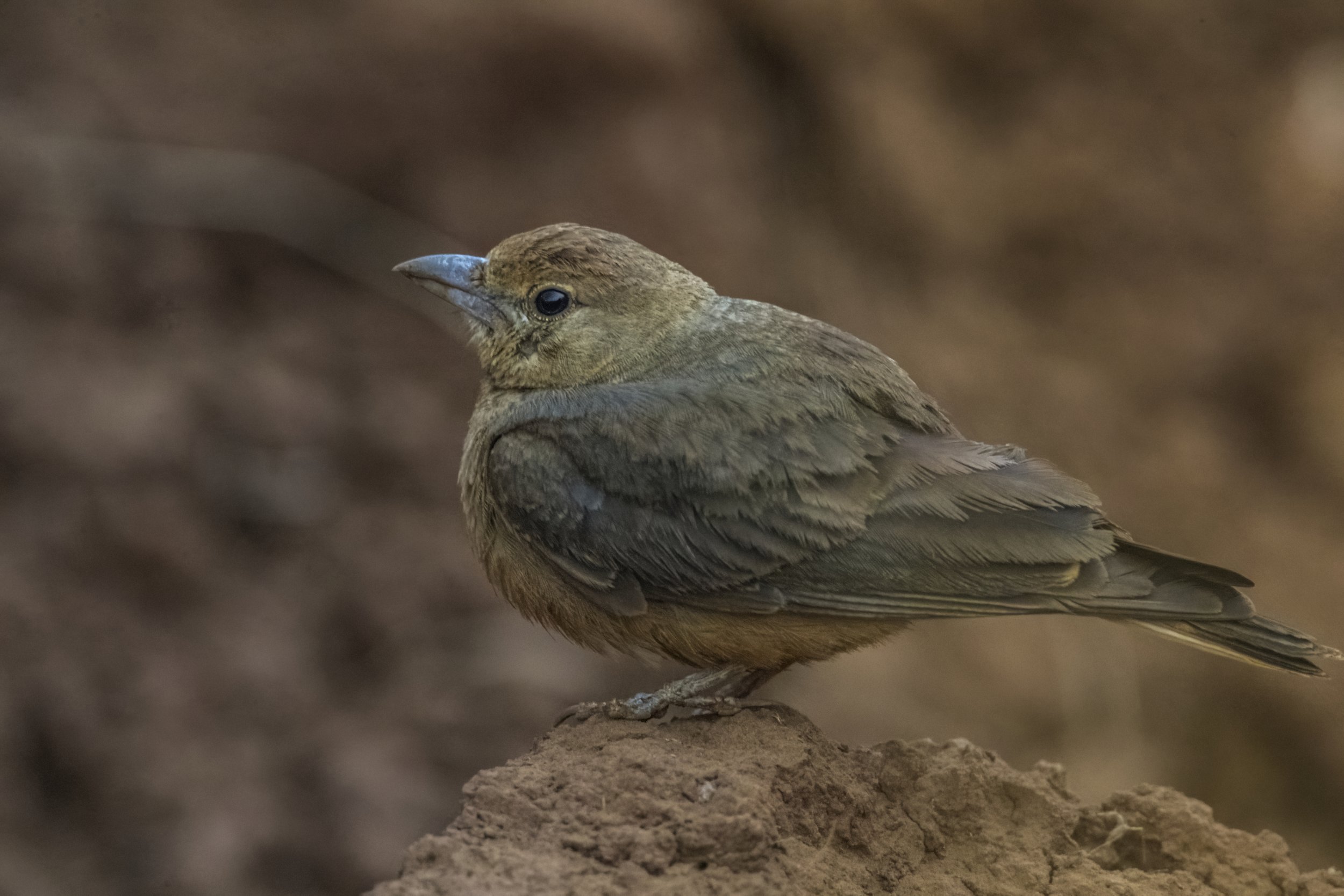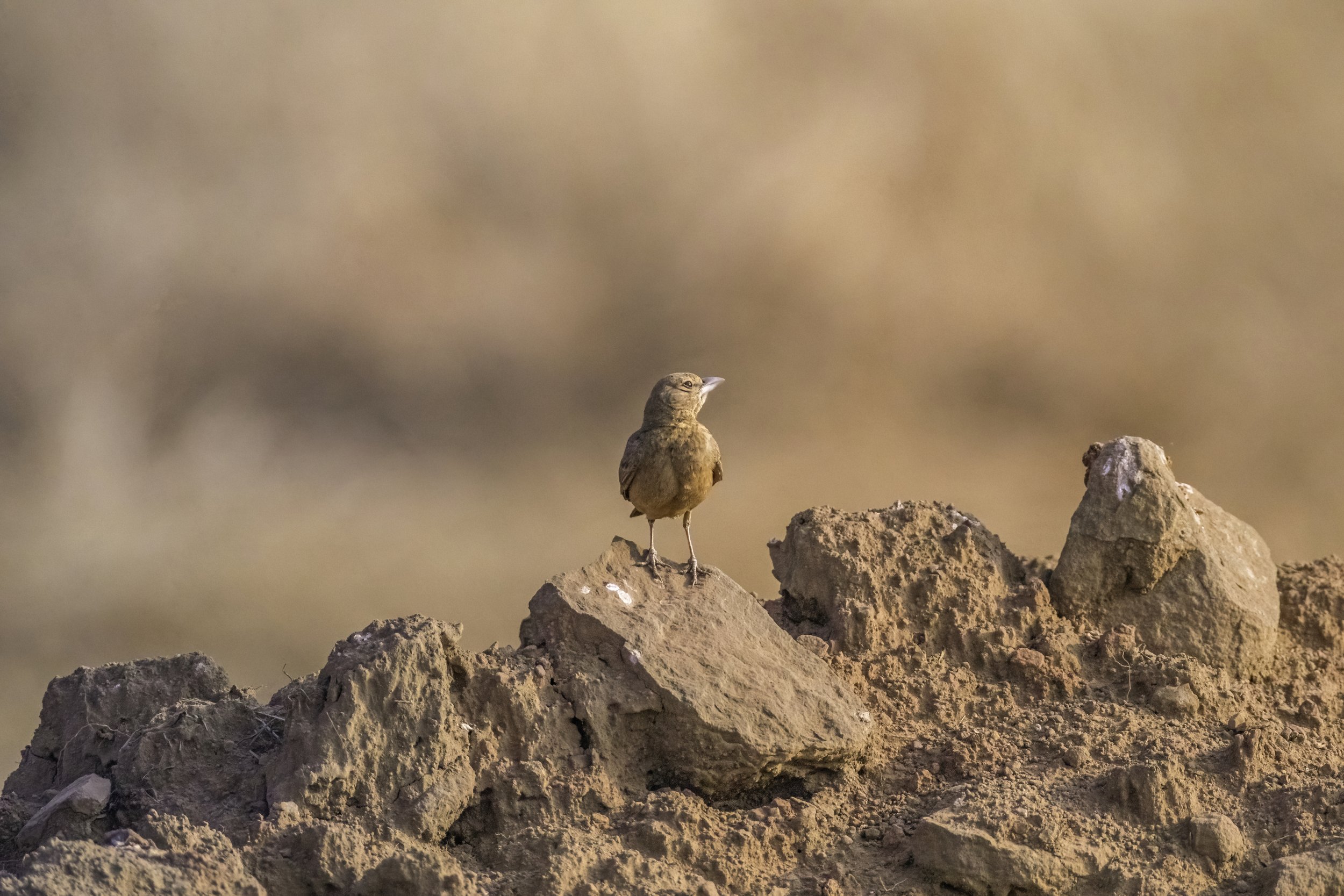Rufous-tailed Lark
Ammomanes phoenicura
Yenkathala Grasslands & Grasslands across India
Telangana is the eleventh largest state in India situated on the south-central stretch of the Indian peninsula on the high Deccan Plateau. It is the twelfth-most populated state in India with a geographical area of 112,077 km² of which 21,214 km² is forest cover. The dry deciduous forests ecoregion of the central Deccan Plateau covers much of the state, including Hyderabad. The characteristic vegetation is woodlands of Hardwickia binata and Albizia amara. Over 80% of the original forest cover has been cleared for agriculture, timber harvesting, or cattle grazing, but large blocks of forest can be found in the Nagarjuna Sagar - Srisailam Tiger Reserve and elsewhere. The more humid Eastern Highlands moist deciduous forests cover the Eastern Ghats in the eastern part of the state. The Central Deccan forests have an upper canopy at 15–25 meters, and an understory at 10–15 meters, with little undergrowth.
The dry sub-humid zone or Dichanthium-cenchrus-lasitrrus type of grasslands are prevalent here and cover almost the entirety of peninsular India except the Nilgiris. One sees thorny bushes like the Acacia catechu or Khair as it is known in Hindi, Mimosa, Zizyphus (Ber) and sometimes the fleshy Euphorbia, along with low trees of Anogeissus letifolia or Axle Wood, Soymida febrifuga - the Indian Redwood - and other deciduous species. Sehima (grass) which is more prevalent on gravel is about 27% of the cover and Dichanthium (grass) which flourishes on level soil is almost 80% of the coverage.
Grasslands are natural carbon sinks and therefore crucial to the global carbon cycle due to their high rates of productivity, enhanced carbon sequestration rates and geographical extent keeping global temperatures more or less in balance. They are also breeding grounds for many migratory and endangered species like the Indian Grey Wolf of which only about 3,000 are left in the wild. It is a common response from people to think forests when green cover is mentioned but grasslands are of equal import. These open natural ecosystems urgently need attention and government initiatives for protection and conservation. In Telangana, grasslands are located in the districts of Vikarabad, Nizamabad, Khammam, Siddipet and Nalgonda. The wildlife in these fragile ecosystems today face numerous threats like hunting, spread of the canine distemper virus which affects foxes, wolves & several other species, rabies from feral dogs and most crucially, habitat loss.
The bird today - the Rufous-tailed Lark is from one such spectacular grasslands about 60 kilometres from the capital city of Hyderabad - the Yenkathala Grasslands, sometimes also called the Ramnathgudpalle Grasslands. These grasslands are home to as many as 191 bird species which include migrants like the Pallid & Montagu’s Harriers who winter here from Russia and Eastern Asian countries traveling over 5,000 kilometers. The rare Indian Grey Wolf has also been spotted here along with a number of foxes.
Read about these rare migrant harriers here.
Read also about the other wildlife that inhabit these and grasslands elsewhere.
The winter weather in Telangana is cold with a mild sun, especially now in January and as the sun rises these grasslands are bathed in a golden hue. The long stalks of grass sway dreamily in the cold, soaking up the sun and a peaceful silence reigns. Slowly the faint, but interminable chirping of birds permeates and breaks the silence with a not so strong wind unobtrusively rustling through the long grass. Butterflies start to flutter, dainty and somewhat ethereal, dragonflies & damselflies hover, fiercely red & floating with intent. These are the base of the pyramid that sustains the cycle of life on these grasslands.
Rufous-tailed Lark
The Rufous-tailed Lark (Ammomanes phoenicura), also sometimes called the Rufous-tailed Finch-lark, is a ground bird found in the drier open stony habitats of India and parts of Pakistan. Like other species in the genus it has a large finch-like bill with a slightly curved edge to the upper mandible. The dull brown colour matches the soil as it forages for grass seeds, grain and insects. Males and females are indistinguishable in the field but during the breeding season, the male has a courtship display that involves flying up steeply and then nose-diving and pulling up in a series of stepped wavy dips accompanied by calling. They forage on the ground in pairs or small groups.
It is a plain, relatively well-proportioned lark which is brownish above and rufous below, with streaks on the breast clearly visible in the photo above. The bill is conical and heavy, and the long wings impart a slender appearance. It inhabits open areas with scrub and rocky landscapes often solitary or in pairs, foraging busily on the ground and often perching on high mounds or on wires. The pleasant song consists of short whistles and liquid trilling notes and it has a melodious metallic ring that is reminiscent of a cow-bell ringing in a distant pasture.
Although not classified as globally threatened by the IUCN Red List, recent assessments of its distribution and population trends found strong declines over the past two decades. There is a need for research to understand the causes of this sharp decline. Studies on the biology of this species are nearly lacking and need to be prioritized.
The Rufous-tailed Lark was originally placed in the genus Mirafra. Alternate names for the Rufous-tailed Lark include Rufous-tailed Desert Lark, and Rufous-tailed Finch-lark.
Some taxonomists in the past included the Bar-tailed Lark as a subspecies of the Rufous-tailed Lark but the two are now generally considered to be separate species. Walter Koelz designated the peninsular Indian population south of a line across India from Hubli to Bellary and to Ellore as a separate subspecies testaceus (=testacea) that has brighter rufous colours. Some later workers treat the species as monotypic because specimens vary in the brightness (the reddest individuals being from Mysore and Salem). Two subspecies are recognized:
A. p. phoenicura - (Franklin, 1831): Found in north-eastern Pakistan and central India
A. p. testacea - Koelz, 1951: Found in southern India
The Rufous-tailed is a sparrow-sized lark (~16 cm) with a robust build and a strong bill. It is darker than similar larks and has relatively few distinctive plumage features. The adult is a dark brown-gray above, with faint paler supercillium. Its wings are dark gray-brown with indistinct paler edges. The upper-tail coverts, undertail coverts, belly, and rest of the underparts are rufous. Tail is also rufous but with broad dark terminal bar. The throat and upper breast are rufous buff, with dark streaks on the breast and underwing. The iris is a dark brown. The bill is largely dark gray above, pale grayish-pink below with a dark tip; and legs are pinkish to dull pinkish brown, often duskier on toes. Both sexes are similar but the female, on average, is smaller than the male. The juvenile differs from the adult in fresh plumage in having slightly more distinct pale buff-rufous fringes above, more distinct pale-tipped wing-coverts and paler underparts with less distinct breast markings. Males and females look alike.
The Rufous-tailed Lark may overlap with the Desert Lark (Ammomanes deserti) along the north-western edge of its distribution, but is distinguished from the latter species by its darker upperparts and rufous underparts. Additionally, the Rufous-tailed Lark has more prominent streaks on the breast and throat, and in flight a distinctive tail pattern. Though once considered conspecific with the Bar-tailed Lark (Ammomanes cinctura), it is more closely related to the Desert Lark. The Bar-tailed Lark is smaller, with a weaker bill, much paler and less rufous below, and in flight shows rufous-orange remiges with dark tips (rather uniformly dark remiges in Rufous-tailed Lark).
Found throughout the peninsula of mainland India. In the north, found from Punjab through Haryana, Delhi, Uttar Pradesh, Bihar, to Bengal in the east. Sporadic records from the terai in western Nepal during non-breeding season. Absent from the wet plains of the Ganga River in Uttar Pradesh. It does not occur in Sri Lanka and the Lakshadweep Islands. It is known in Kerala from a few records around the Palghat gap and is absent from the hilly and moist forests of the Western Ghats. It is widespread throughout the drier rain-shadow areas of the Deccan plateau and Central India and common in Gujarat and Rajasthan. It is known from the Jhelum and Shahpur Districts of Pakistan, but probably irregular.
It prefers dry open habitats like scrub forest, savannah, deciduous forest, and seasonal agricultural & fallow fields with sparse vegetation. It is most common in the dry grasslands with rocky outcrops of the Deccan Plateau. Favours short grass with patches of bare ground more than long & dense grass. Common around fallow lang in rural areas but absent from urban regions. It is often found together with other species, such as the Ashy-crowned Sparrow-lark (Eremopterix griseus).
In 2023, State of India's Birds estimated a distributional range of 10,47,290 km2 (C.I. = 1,046,710; 1,047,870 km²) within India.
Not globally threatened (least concern) as per IUCN Redlist and included in the Schedule IV of the Indian Wildlife Protection Act, 1972. The Rufous-tailed Lark is often described as locally common, especially in the northern part of the Indian range. However, the two-decade long decline estimated by the State of India's Birds report 2023 is a strong reason for concern. This reports lists it as species of 'High' conservation concern because it has a large distribution (10,47,290 km²) and the population is estimated to be in rapid decline. Conservation status in Pakistan and Nepal is uncertain but possibly it was always only an erratic visitor to these regions during the monsoon season. There are no documented impacts of human activities on the conservation status of the Rufous-tailed Lark. However, there is no knowledge on the causes of decline of this species over the past two decades. Given that a majority of its distribution range occurs in agricultural areas, it is likely that changes in agricultural practices and cropping patterns are having an impact on the population of this species.
I think from a future perspective research priorities for the Rufous-tailed Lark should include:
understanding the causes for the long-term population decline
is the decline uniform across its entire range
Are there clearly defined areas where the decline is more than others
Are the causes of decline similar across the range
A large proportion of the rufous-tailed larks distribution range is under agricultural production, hence it is important to understand the impacts of changes in agricultural practices on the population and demography of this species. The breeding biology of this species is poorly studied too and knowledge of breeding biology will be crucial to understand some of the patterns of decline and to predict future impacts. Despite it being a common bird, there is little to no documentation of its diet. Building an understanding of the diet of this species across its range can also be an important research priority.
‡‡‡‡‡
Related Posts






















